Lough Neagh
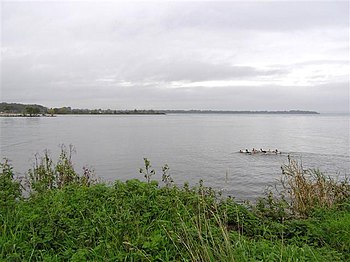
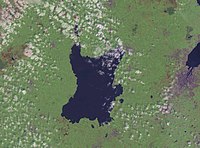
Lough Neagh, sometimes Loch Neagh is a vast freshwater lake in Northern Ireland, the biggest lake in the British Isles, supplying 40% of the water of Northern Ireland. The lough is bordered by all but one of Northern Ireland’s six counties, whose borders circle it like the spokes of a wheel:
- County Antrim (east)
- County Down (south-east)
- County Armagh (south)
- County Tyrone (south-west)
- County Londonderry (north-west)
The name of the lough comes from the Gaelic tongue spoken here of old, believed to be from Loch nEathach, meaning "Lake of Eathach".
Geography
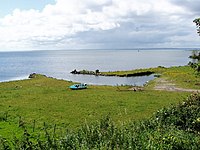
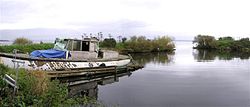
Lough Neagh spreads out over an area of 151 square miles, which makes it by far the greatest lake in the British Isles (and even in the continent of Europe few freshwater lakes exceed it); it is ranked 31st in the list of largest lakes of Europe.
The lough is approximately twenty miles long and nine miles wide. It is very shallow around the margins and the average depth in the main body of the lake is about 30 feet; although at its deepest the lough is about 80 feet deep.
Lough Neagh is fed by numerous rivers: the rivers and streams feeding it drain 43% of the area of Northern Ireland, and much of County Monaghan across the border.[1] It is drained in turn by the Lower Bann, which flows out of Lough Neagh's northernmost spur to run northwards to the sea. (Just a mile to the north though the Bann expands into another lake, Lough Beg, before finally escaping as a free river.)
It found twenty miles to the west of Belfast.
Islands
Lough Neagh is a vast scoop out of the ground, or a depression in it. Despite its size, the lough has very few islands, and these close to the shoreline:
- Coney Island
- Coney Island Flat
- Croaghan Flat
- Derrywarragh Island
- Padian
- Ram's Island
- Phil Roe's Flat
- The Shallow Flat
Hydrology
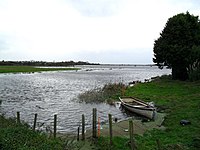
Of the 1,760 square-mile catchment area, around 9% lies in the Republic of Ireland and 91% in Northern Ireland;[2] altogether 43% of the land area of Northern Ireland is drained into the lough,[3] which itself flows out northwards to the sea via the River Bann. As one of its sources is the Upper Bann, the Lough can itself be considered a part of the Bann.
Legends
An old Irish story tells how the Lough was formed when Ireland's legendary giant Fionn mac Cumhaill (Finn McCool) scooped up a portion of the land and tossed it at a Scottish rival. He missed, and the chunk of earth landed in the Irish Sea, thus creating the Isle of Man.
Another legend has it that a shepherd boy was set to watch a dyke which held back the waters of the Bann, but he slept and neglected his duty, the waters burst out and drowned the landscape.
Lough shore
Five of the six counties of Northern Ireland have shores on the Lough; only Fermanagh does not. The counties are listed clockwise:
Towns and villages near the Lough include:
Uses
Although the Lough is used for a variety of recreational and commercial activities, it is exposed and tends to get extremely rough very quickly in windy conditions. It is also used as a source of fresh water by Northern Ireland Water. Plans to increase the amount of water drawn from the Lough, through a new water treatment works at Hog Park Point, have long been planned but are yet to materialise.
Traditional working boats on Lough Neagh include wide-beamed 16- 21 feet clinker-built, sprit-rigged working boats and smaller flat-bottomed "cots" and "flats". Barges, here called "lighters", were used up to the 1940s to transport coal over the lough and adjacent canals. Up to the 17th century, log boats (coití) were the main means of transport. Few traditional boats are left now, but a community-based group on the southern shore of the lough is rebuilding a series of working boats.[4]
In the 19th century, three canals were constructed, making use of the lough to link various ports and cities: the Lagan Navigation provided a link from the city of Belfast, the Newry Canal linked to the port of Newry, and the Ulster Canal led to the Lough Erne navigations, providing a navigable inland route by way of the River Shannon to Limerick, Dublin and Waterford. The Lower Bann was also navigable to Coleraine and the Antrim coast, and the short Coalisland Canal provided a route for coal transportation. Of these waterways, only the Lower Bann remains open today, although a restoration plan for the Ulster Canal is currently in progress.
Lough Neagh Rescue provides a Search & Rescue service twenty-four hours a day. It is a voluntary service with funding being provided by the District Councils bordering the Lough, its members are highly trained and are a declared facility for the Marine Coastguard Agency who co-ordinate rescues on Lough Neagh Maritime and Coastguard Agency.
Lough Neagh attracts bird watchers from many nations due to the number and variety of birds which winter and summer in the boglands and shores around the lough.
Eel fishing has been a major industry in Lough Neagh for centuries. Today Lough Neagh eel fisheries export their eels to restaurants all over the world and Lough Neagh Eel has been granted Protected Geographical Status under European Union law.[5]
Lough Neagh was widely assumed to be owned by the state, but in 2005 it publicly emerged that it is the ancestral property of the Earl of Shaftesbury. This may have serious implications for planned changes to state-run domestic water services in Northern Ireland, as the lough supplies 40% of the region's drinking water and is also used as a sewage outfall (in a system only permissible through British Crown immunity).[6] In 2012, it was reported that the Earl is considering transferring ownership of the Lough to the Northern Ireland Assembly. [7]
Gallery
-
Lough Neagh at Killywoolaghan, County Tyrone
-
Lough Neagh near Ardmore Point
-
Lough Neagh at Shane's Castle, County Antrim
-
Lough Neagh at Gawley's Gate, County Antrim
-
Lough Neagh at Maghery, County Armagh
-
Lough Neagh at Ballyronan, County Londonderry
Outside links
- Location map: 54°37’6"N, 6°23’43"W
- Discover Lough Neagh
- Lough Neagh Rescue
- Lough Neagh Boating Heritage Association
- BBC News on pollution
- BBC News on ownership of Lough Neagh
- Oxford Island National Nature Reserve
References
- ↑ Infrastructure NI: Lough Neagh levels
- ↑ "Lough Neagh". UK Environmental Change Network. http://www.ecn.ac.uk/sites/site/lakes/lough-neagh. Retrieved 4 March 2012.
- ↑ Northern Ireland Rivers Agency
- ↑ Lough Neagh Boating Heritage Association
- ↑ Official list of UK protected foods. Accessed 15 July 2011.
- ↑ "Sudden death may impact NI water". BBC News. 19 May 2005. http://news.bbc.co.uk/1/hi/northern_ireland/4563853.stm.
- ↑ "Earl of Shaftesbury does not rule out Lough Neagh sale". BBC News. http://www.bbc.co.uk/news/uk-northern-ireland-19840966.





